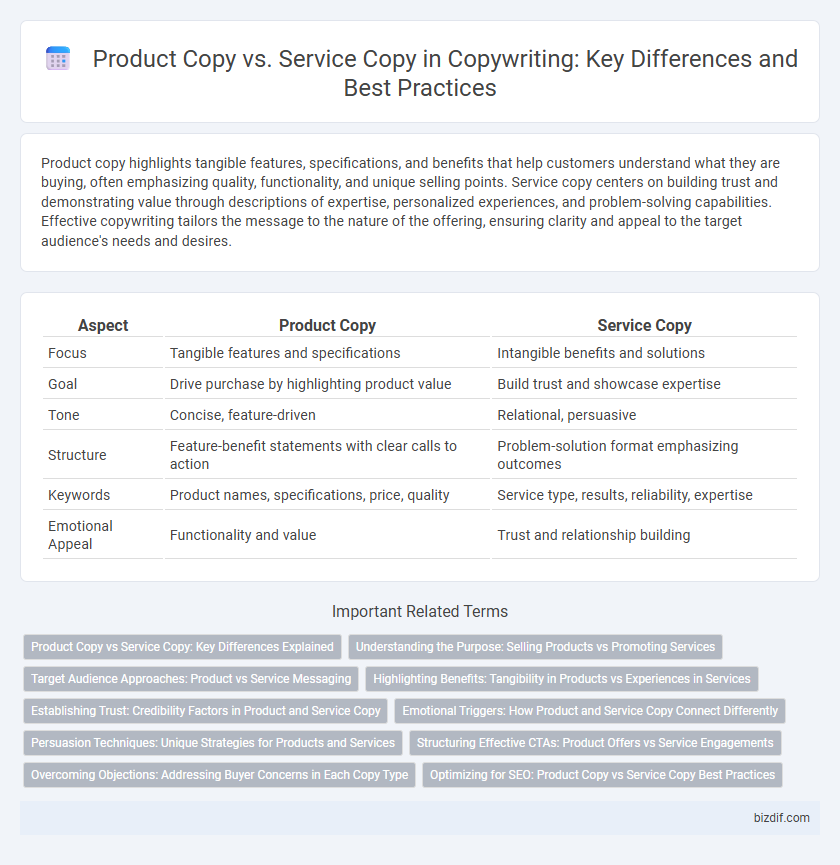Product copy highlights tangible features, specifications, and benefits that help customers understand what they are buying, often emphasizing quality, functionality, and unique selling points. Service copy centers on building trust and demonstrating value through descriptions of expertise, personalized experiences, and problem-solving capabilities. Effective copywriting tailors the message to the nature of the offering, ensuring clarity and appeal to the target audience's needs and desires.
Table of Comparison
| Aspect | Product Copy | Service Copy |
|---|---|---|
| Focus | Tangible features and specifications | Intangible benefits and solutions |
| Goal | Drive purchase by highlighting product value | Build trust and showcase expertise |
| Tone | Concise, feature-driven | Relational, persuasive |
| Structure | Feature-benefit statements with clear calls to action | Problem-solution format emphasizing outcomes |
| Keywords | Product names, specifications, price, quality | Service type, results, reliability, expertise |
| Emotional Appeal | Functionality and value | Trust and relationship building |
Product Copy vs Service Copy: Key Differences Explained
Product copy emphasizes tangible features, specifications, and benefits, aiming to showcase physical attributes and direct functionality to prompt purchase decisions. Service copy highlights intangibles such as expertise, customer experience, and ongoing support, focusing on trust-building and relationship development. Understanding these key differences optimizes messaging strategies for clarity and engagement in diverse marketing contexts.
Understanding the Purpose: Selling Products vs Promoting Services
Product copy emphasizes tangible features, benefits, and specifications to drive immediate purchases, highlighting quality and value. Service copy focuses on building trust, showcasing expertise, and emphasizing customer experience to foster long-term relationships. Understanding these distinct purposes enables tailored messaging that effectively appeals to target audiences and achieves marketing goals.
Target Audience Approaches: Product vs Service Messaging
Product copy focuses on highlighting tangible features and benefits that appeal to customers seeking specific solutions or enhancements, emphasizing technical specifications, quality, and value. Service copy targets emotional engagement by showcasing personalized experiences, trust, problem-solving capabilities, and ongoing support tailored to client needs. Understanding the target audience's decision-making process drives the distinction between product messaging's clarity and service messaging's relational tone.
Highlighting Benefits: Tangibility in Products vs Experiences in Services
Product copy emphasizes tangible benefits such as features, quality, and usability that customers can physically interact with, enhancing their sense of value and reliability. Service copy highlights experiential benefits like customer satisfaction, personalized support, and emotional impact, creating trust and building long-term relationships. Focusing on these distinct advantages helps tailor messaging to meet customer expectations effectively in both product and service marketing.
Establishing Trust: Credibility Factors in Product and Service Copy
Establishing trust in product copy relies heavily on tangible credibility factors such as product specifications, certifications, and customer reviews that validate quality and performance. Service copy builds credibility by highlighting expertise, customer testimonials, guarantees, and transparent processes that assure reliability and professionalism. Both approaches leverage social proof and clear, honest information to foster confidence and reduce buyer hesitation effectively.
Emotional Triggers: How Product and Service Copy Connect Differently
Product copy leverages sensory and tangible emotional triggers, emphasizing features like texture, design, and immediate benefits to create desire and anticipation. Service copy taps into trust, reliability, and personal transformation, highlighting ongoing support and emotional security to build long-term relationships. Emotional triggers in product copy often evoke excitement and impulse, while service copy focuses on reassurance and confidence in decision-making.
Persuasion Techniques: Unique Strategies for Products and Services
Product copy leverages sensory language and vivid imagery to create a tangible experience, emphasizing features and benefits that drive immediate consumer desire. Service copy relies on trust-building techniques, social proof, and emphasizing personalized solutions to alleviate customer concerns and highlight ongoing value. Both require tailored emotional appeals: products focus on instant gratification, while services prioritize reliability and relationship-building.
Structuring Effective CTAs: Product Offers vs Service Engagements
Product copy demands clear, action-oriented CTAs like "Buy Now" or "Add to Cart," emphasizing immediate purchase decisions and highlighting product benefits or discounts. Service copy requires CTAs that foster engagement, such as "Schedule a Consultation" or "Request a Quote," focusing on building trust and demonstrating expertise. Structuring effective CTAs involves tailoring language and placement to match buyer intent, ensuring conversions through relevance and clarity.
Overcoming Objections: Addressing Buyer Concerns in Each Copy Type
Product copy overcomes objections by highlighting tangible benefits, quality assurances, and detailed specifications that build trust and reduce perceived risk. Service copy addresses buyer concerns through clear explanations of expertise, guarantees, and customer support, emphasizing reliability and personalized solutions. Both types strategically incorporate testimonials and FAQs to alleviate doubts and reinforce credibility.
Optimizing for SEO: Product Copy vs Service Copy Best Practices
Product copy focuses on detailed descriptions, specifications, and benefits to enhance keyword relevance and improve search engine rankings for specific items. Service copy emphasizes problem-solving, client testimonials, and clear calls to action that target service-related queries and boost local SEO performance. Optimizing product and service copy requires tailored keyword research, user intent analysis, and structured formatting to maximize organic visibility and conversion rates.
Product Copy vs Service Copy Infographic

 bizdif.com
bizdif.com